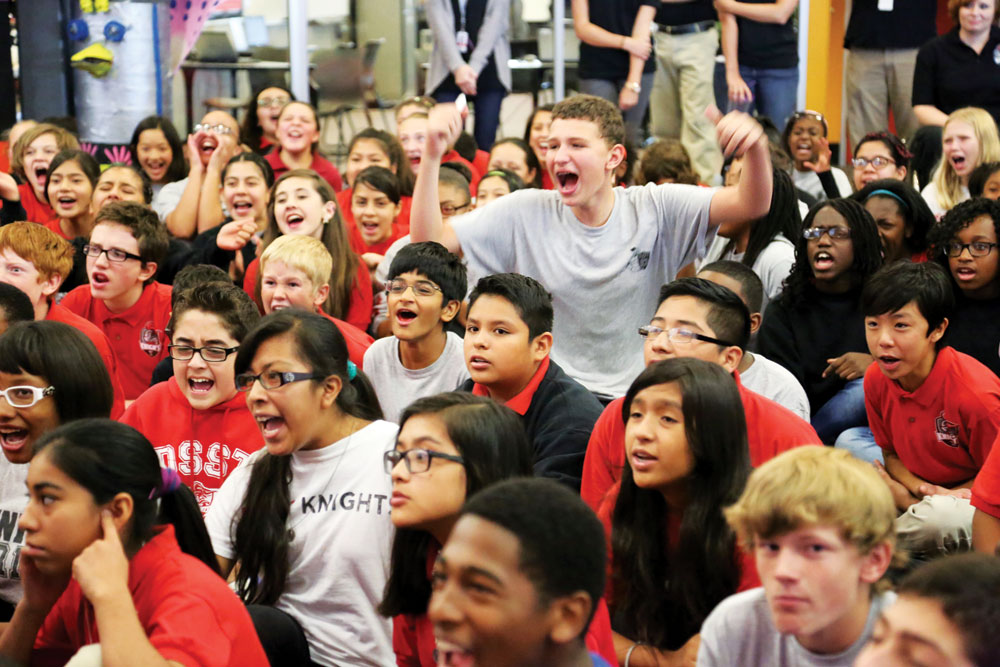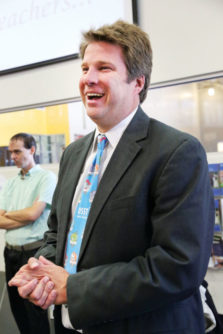
Stapleton middle school celebrates having no achievement gap and having the second highest school performance score in the city.
DSST Public Schools has the best partnership in the country with the public school system, says Nina Rees, president and CEO of the National Alliance for Public Charter Schools. She says Denver is always highlighted as an example of how charters can work closely with traditional system—one of only a few places that is the case. “Bill Kurtz (CEO of DSST Public Schools) has received numerous awards. We thought it was time to induct him in the Charter Schools’ Hall of Fame.”

DSST Public Schools CEO, applauds the students’ success.
Rees cites Kurtz’ business acumen and his work on the ground running schools and managing a network of some of the best schools in the country. The Alliance is especially honoring him for his leadership and impact he can have helping other schools around the country get started. “We hope newcomers will either visit Bill or reach out and take a page out of what he’s done and replicate those best practices as they run their schools.” Although serving a diverse population was not part of the criteria for the award, Rees acknowledged that is a significant issue and “it definitely factored into his selection.”
We asked Kurtz what the biggest challenges were in getting DSST started 12 years ago. He says it was convincing themselves, faculty, families and students that they could create a school where all would get a chance for a world class education. “If you don’t believe that, you can’t create schools that succeed at that.”
The second big challenge was that running great schools is hard. “You have to create systems and processes and cultures that are excellent every day because we need our kids to be excellent and learn in an extraordinary way every day. If we expect that of them, we have to expect that of ourselves. It takes lots of attention to detail, lots of clarity on where you’re trying to go and how you’re going to get there. It’s harder than it might seem, but so important to creating a great school.”
Those challenges are still true today, says Kurtz, but he cites an additional issue that feels more difficult today than it did 12 years ago.
“I do think our country’s in a really challenging spot with what’s gone on across this country recently. And the level of difference and the level of prejudice and the inability to have a discourse that’s productive makes our education system and our schools even more important in building understanding across difference. We need to have kids who go to school together who look different and who come from different backgrounds. I believe the only way we’re going to cross the divide in this country is if we really create opportunities for our young people to live, learn and play together every day with people who are different than they are.”
Kurtz went on to describe the impact DSST has had nationally. First, he says, there’s a growing national movement that schools that are integrated and diverse by design are really important to our society. “We’ve proven nationally how that work can be successful for all kids. We deeply believe in it. Many schools across the country will cite us as being one of their important influences in creating schools that are diverse by design like we are.”
Secondly he cited DSST’s commitment to living by a set of values and helping young people become value driven. “The culture and commitment we created has been important to the national conversation helping schools think about how to do that well.”
Third, DSST’s success giving all kids the opportunity to go to a four-year college has been noticed and causes other schools to think about how to do their work differently.
DSST has been “a big player in the STEM (science, technology, engineering, math) movement, influencing other schools on how to do great STEM education.
Finally, Kurtz says, “We have paved the way for people to think differently about how charters and school districts can work together to benefit the community, kids and families.”




0 Comments